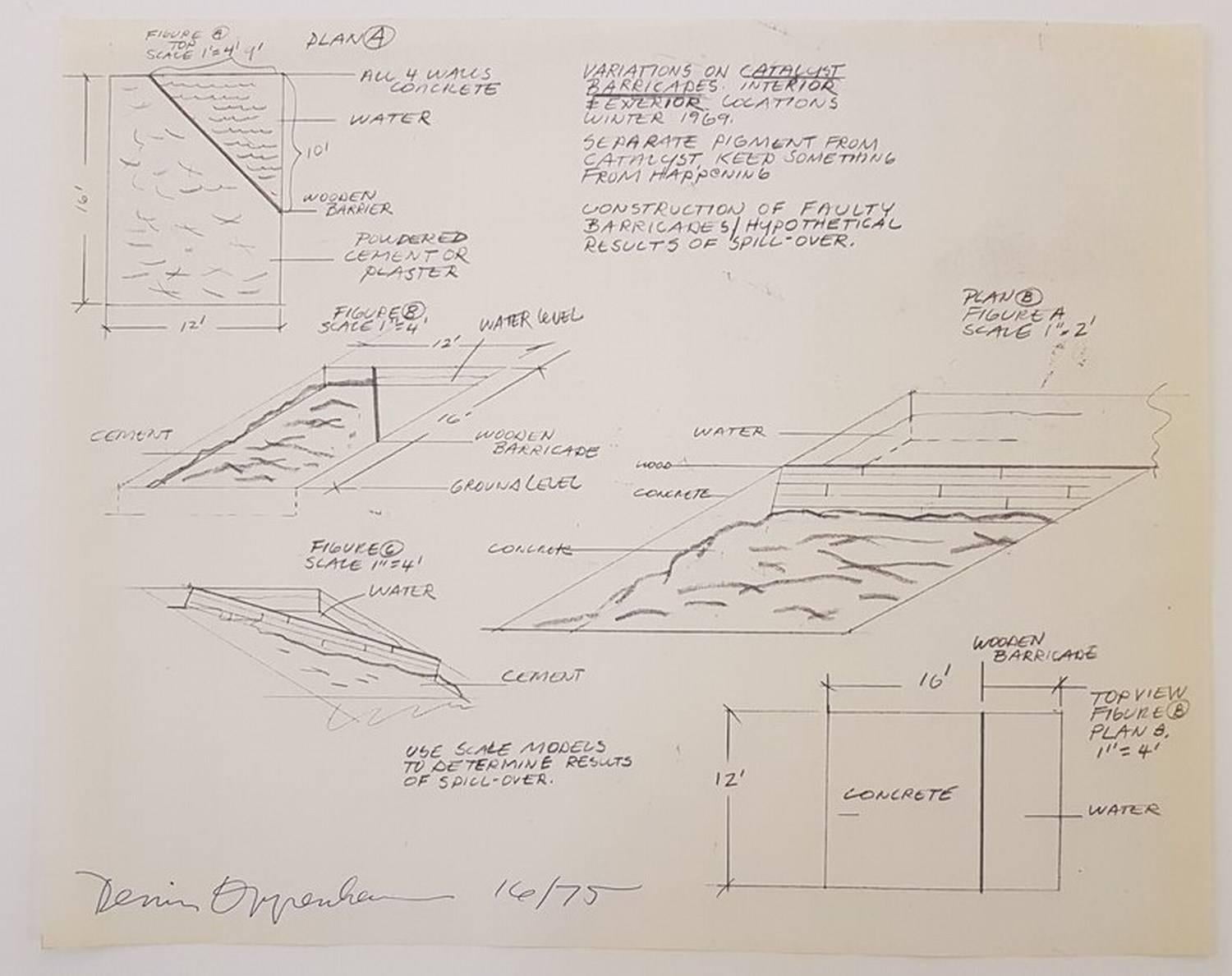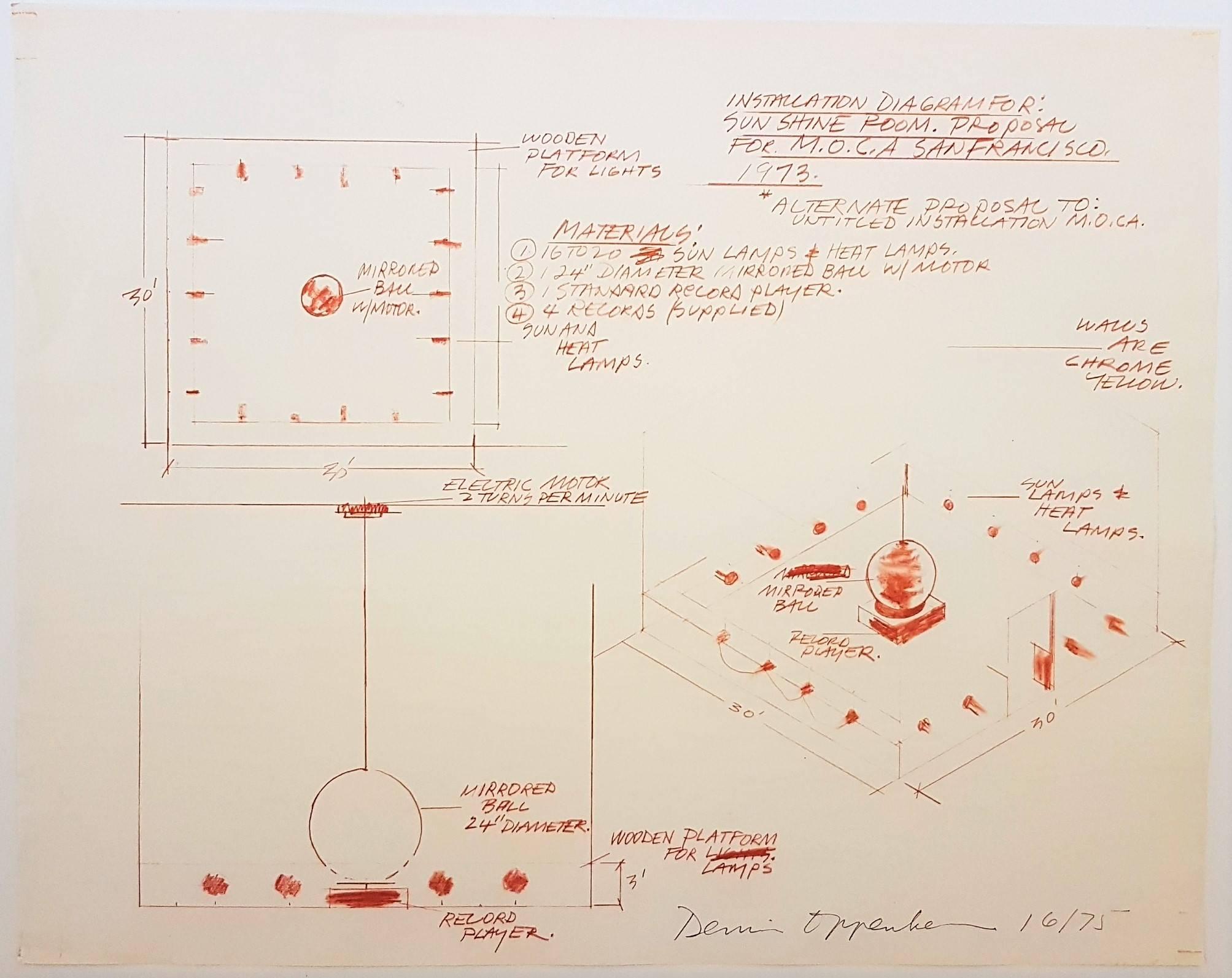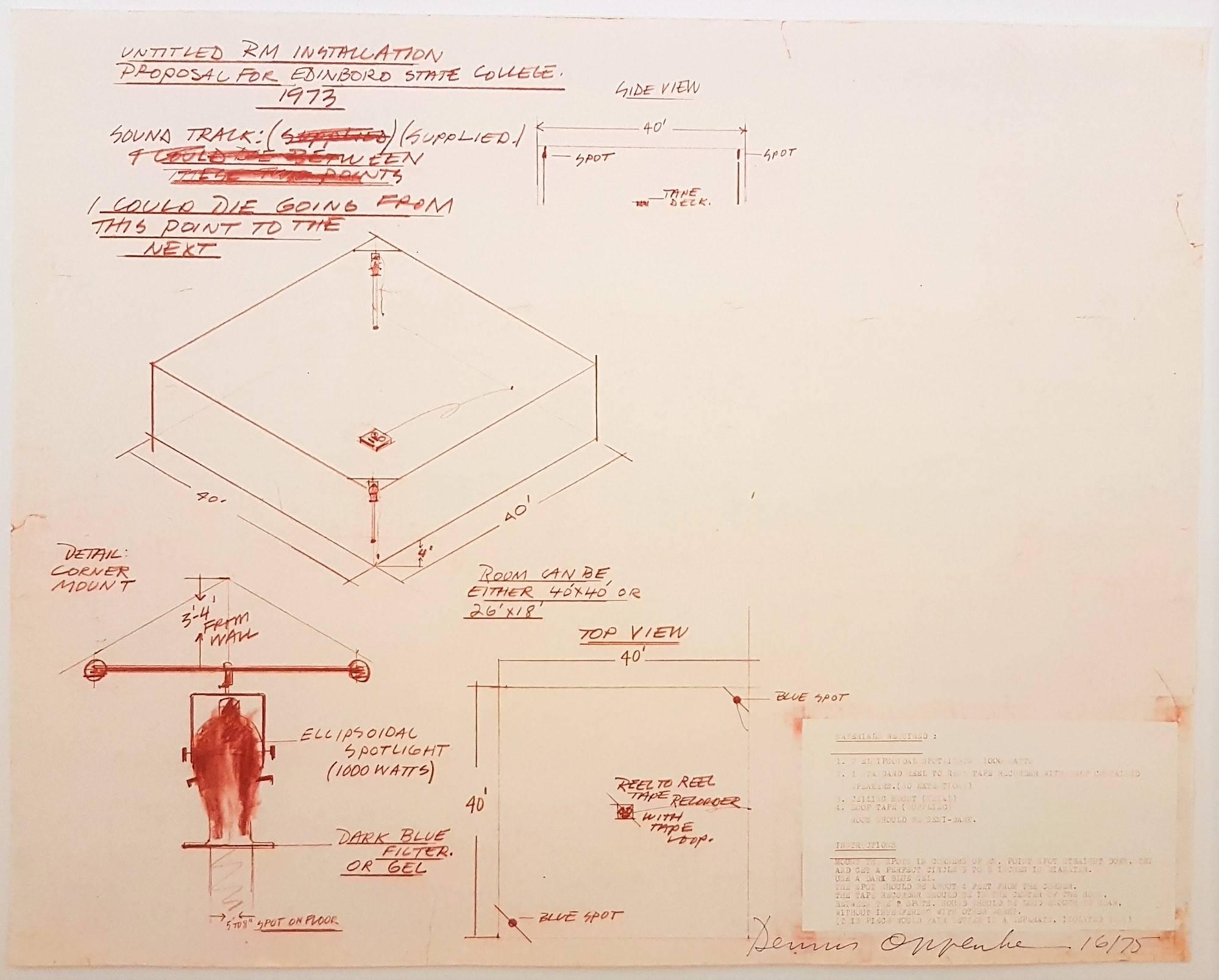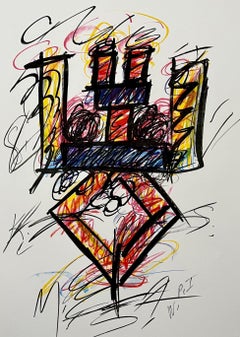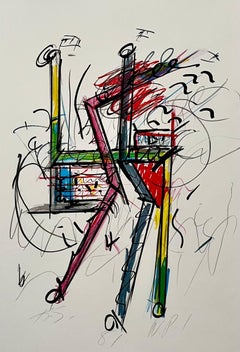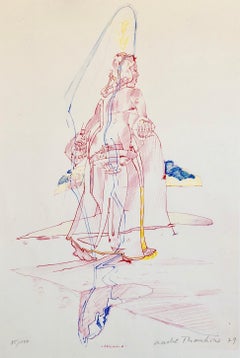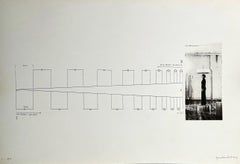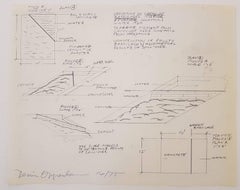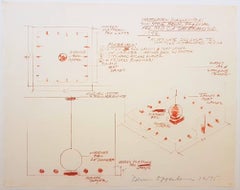Items Similar to Dennis Oppenheim Large Abstract Conceptual Sculpture Drawing for Ace Gallery LA
Want more images or videos?
Request additional images or videos from the seller
1 of 20
Dennis OppenheimDennis Oppenheim Large Abstract Conceptual Sculpture Drawing for Ace Gallery LA1979
1979
$8,500
£6,496.54
€7,487.78
CA$12,173.63
A$13,341.93
CHF 6,967.41
MX$160,087.80
NOK 87,487.75
SEK 82,410.21
DKK 55,914.56
About the Item
Dennis Oppenheim (1938 - 2011)
Pencil and colored pencil drawing on paper,
'Memory Generator Receiver; Transmitter project for ACE Gallery Los Angeles'
(possibly with watercolor painting wash or pigment on paper)
Date: 1979
Signed: Hand signed
Dimensions: Framed Dimensions: 38.5 x 50.25 in
Dennis Oppenheim (1938 – 2011) was an American conceptual artist, performance artist, earth artist, sculptor and photographer.
He attended the California College of Arts and Crafts, In 1964, he earned a Bachelor of Fine Arts degree from the California College of Arts and Crafts in Oakland and an MFA from Stanford University in Palo Alto in 1965. In 1981 he married the sculptor Alice Aycock who remained a close friend. In 1998 he married Amy Plumb and they remained married.
His whose work encompassed sculptural installation, performance, and film. Oppenheim’s work, like the works of his peer Robert Smithson, sought to break sculpture out of traditional modes and pose questions rather than signify aesthetic allegiances. “Most of my work comes from ideas. I can usually do only a few versions of each idea. Land Art and Body Art were particularly strong concepts which allowed for a lot of permutations,” he once reflected. Oppenheim began experimenting with video art and performance during the 1970s, and made major contributions to the history of sculpture within public spaces throughout the remainder of his career. Today, his works are held in the collections of the Denver Museum of Art, the Cranbrook Academy of Art in Bloomfield Hills, MI, the Centre Georges Pompidou in Paris, the National Gallery of Art in Washington, D.C., The Museum of Modern Art in New York, and the Tate Gallery in London, among others.
Contemporary Art, Photography, Sculpture, Urban Art
Related Artists Vito Acconci, Richard Long, Richard Long, Bruce Nauman, Claes Oldenburg and Robert Smithson. Oppenheim occupied a live-work loft in Tribeca from 1967 until his death.
Executed in New York, Paris and Amsterdam and documented in photography, the series Indentations, conceptual works, (1968) consisted of the removal of objects, exposing the impression of each object at that location. Viewing Stations (1967) were built as platforms for observing land vistas, suggesting an embodied notion of vision. The artist presents the base as the art itself, a viewer becomes an object to be looked at, a conceptual reversal.
Earthworks, Body – performance works, Genetic works, Film / video installations: Oppenheim began to produce installation art in the early seventies. These works were often autobiographical. In Recall (1974), a video monitor is an installation component, positioned in front of a pan of turpentine. The monitor shows a close up of Oppenheim's mouth as he verbalizes a stream-of-consciousness monologue induced by the smell, on his experiences in art school in the fifties.
Post-performance- biographical works:
In a series of eight works Oppenheim called "post-performance," the artist spoke through his surrogate performance figures about the end of the avant-garde, his own art-making, in dialogue as opposites or as in
Machineworks:
In the early eighties, room size sculptural installations took the form of factories and machines to visualize the genesis of an artwork before it becomes form. Final Stroke- Project for a Glass Factory (1981) analogized thinking patterns as moving parts. Vacuum cleaners and powered heaters activated raw material through sieves, troughs, stacks and vents, as the stages of processing in the production of ideas. The machines became projection structures for fireworks, producing thought lines in the air, as in Newton Discovering Gravity (1984).
Sculpture:
While he continues to use sound, light and motion in the sculptural work in the late eighties, the imagery includes ordinary objects in different scales or as a collision of objects. In several works, animals appear. A group of taxidermy deer produce flames from the tips of their antlers, in Digestion. Gypsum Gypsies. (1989).
Public Sculpture:
Oppenheim experimented with titled and cantilevered form in Device to Root Out Evil (1997). Included as part of the Venice Biennale, it uses hand blown Venetian glass on the country church's roof and steeple. In 1999, a version using translucent corrugated fiberglass was installed as a permanent work in Palma de Mallorca.
This was done for famed Los Angeles Gallery, Ace Gallery. owned by Doug Chrismas. In the 60s and early 70s he brought artists such as Robert Rauschenberg, Carl Andre, Sol LeWitt, Bruce Nauman, and Donald Judd to Vancouver, Canada. The gallery expanded to Los Angeles in 1967 at the former Virginia Dwan Gallery space in Westwood, and then further expanded to New York in 1994. Doing exhibitions in conjunction with cultural institutions such as the Guggenheim Museum and the Cartier Foundation (Paris). In 1972, Chrismas mounted the Robert Irwin installation Room Angle Light Volume at the first ACE/Venice, which opened at 72 Market Street in 1971. In 1977, ACE mounted exhibitions of work by Andy Warhol, Frank Stella and Robert Motherwell, along with Michael Heizer
- Creator:Dennis Oppenheim
- Creation Year:1979
- Dimensions:Height: 38.5 in (97.79 cm)Width: 50.25 in (127.64 cm)
- Medium:
- Period:
- Condition:This has been well protected in frame. the piece has some minor stains as is typical for such work. Please see photos.
- Gallery Location:Surfside, FL
- Reference Number:1stDibs: LU38213795402
About the Seller
4.9
Platinum Seller
Premium sellers with a 4.7+ rating and 24-hour response times
Established in 1995
1stDibs seller since 2014
1,817 sales on 1stDibs
Typical response time: 1 hour
- ShippingRetrieving quote...Shipping from: Surfside, FL
- Return Policy
Authenticity Guarantee
In the unlikely event there’s an issue with an item’s authenticity, contact us within 1 year for a full refund. DetailsMoney-Back Guarantee
If your item is not as described, is damaged in transit, or does not arrive, contact us within 7 days for a full refund. Details24-Hour Cancellation
You have a 24-hour grace period in which to reconsider your purchase, with no questions asked.Vetted Professional Sellers
Our world-class sellers must adhere to strict standards for service and quality, maintaining the integrity of our listings.Price-Match Guarantee
If you find that a seller listed the same item for a lower price elsewhere, we’ll match it.Trusted Global Delivery
Our best-in-class carrier network provides specialized shipping options worldwide, including custom delivery.More From This Seller
View All1981 American Post Minimalist Abstract Art Lithograph Neon Series Keith Sonnier
By Keith Sonnier
Located in Surfside, FL
Keith Sonnier, American (1941-2020)
lithograph
From Neon series
circa 1980-1981
Bears the Waterstreet Press watermarks and Arches paper blind stamp to lower right corner. Pub. Edizioni Lucio Amelio
Hand signed with initials in pencil
Dimensions: 30 x 21 3/4 inches
Post minimalist Abstract by Keith Sonnier
Keith Sonnier (1941 – 2020) was a post minimalist sculptor, performance artist, video and light artist. Sonnier was one of the first artists to use light in sculpture in the 1960s. With his use of neon in combination with ephemeral materials he achieved international recognition. Sonnier was part of the Process Art movement.
James Keith Sonnier was born July 31, 1941, in Mamou, Louisiana. His family was Cajun and Roman Catholic. His father was a hardware store owner, Joseph Sonnier, and his mother was a florist and singer, Mae Ledoux. He graduated in 1963 from Southwestern Louisiana Institute (now known as the University of Louisiana at Lafayette). In 1966, he graduated with his MFA degree from Rutgers University, where he studied under Allan Kaprow, Robert Watts, and Robert Morris. After graduation from Rutgers, he moved to New York City with Jackie Winsor and some of his former classmates.
Sonnier died in Southampton, NY on July 18, 2020.
Sonnier began experimenting with neon in 1968. Neon lights became a signature material used in his sculptural works. The common materials Sonnier employed included neon and fluorescent lights; reflective materials; aluminum and copper; and glass and wires. Of the generation of James Turrell and Dan Flavin, He was also associated with the Light and Space movement, a loosely affiliated art movement related to op art, minimalism and geometric abstraction originating in Southern California in the 1960s and influenced by John McLaughlin. It is characterized by a focus on perceptual phenomena, such as light, volume and scale, and the use of materials such as glass, neon, fluorescent lights, resin and cast acrylic, often forming installations conditioned by the work's surroundings. Artists included Ron Cooper...
Category
1980s Post-Minimalist Abstract Prints
Materials
Paper
1981 American Post Minimalist Abstract Art Lithograph Neon Series Keith Sonnier
By Keith Sonnier
Located in Surfside, FL
Keith Sonnier, American (1941-2020)
lithograph
From Neon series
circa 1980-1981
Bears the Waterstreet Press watermarks and Arches paper blind stamp to lower right corner. Pub. Edizioni Lucio Amelio
Hand signed with initials in pencil
Dimensions: 30 x 21 3/4 inches
Post minimalist Abstract by Keith Sonnier
Keith Sonnier (1941 – 2020) was a post minimalist sculptor, performance artist, video and light artist. Sonnier was one of the first artists to use light in sculpture in the 1960s. With his use of neon in combination with ephemeral materials he achieved international recognition. Sonnier was part of the Process Art movement.
James Keith Sonnier was born July 31, 1941, in Mamou, Louisiana. His family was Cajun and Roman Catholic. His father was a hardware store owner, Joseph Sonnier, and his mother was a florist and singer, Mae Ledoux. He graduated in 1963 from Southwestern Louisiana Institute (now known as the University of Louisiana at Lafayette). In 1966, he graduated with his MFA degree from Rutgers University, where he studied under Allan Kaprow, Robert Watts, and Robert Morris. After graduation from Rutgers, he moved to New York City with Jackie Winsor and some of his former classmates.
Sonnier died in Southampton, NY on July 18, 2020.
Sonnier began experimenting with neon in 1968. Neon lights became a signature material used in his sculptural works. The common materials Sonnier employed included neon and fluorescent lights; reflective materials; aluminum and copper; and glass and wires. Of the generation of James Turrell and Dan Flavin, He was also associated with the Light and Space movement, a loosely affiliated art movement related to op art, minimalism and geometric abstraction originating in Southern California in the 1960s and influenced by John McLaughlin. It is characterized by a focus on perceptual phenomena, such as light, volume and scale, and the use of materials such as glass, neon, fluorescent lights, resin and cast acrylic, often forming installations conditioned by the work's surroundings. Artists included Ron Cooper...
Category
1980s Post-Minimalist Abstract Prints
Materials
Paper, Lithograph
1970s Modernist Swiss Colorful Surrealism Signed Dada Lithograph Andre Thomkins
By André Thomkins
Located in Surfside, FL
This one is titled "Halemaid" and depicts a surreal figure of a robed woman in yellow red and blue with a Salvador Dali esque quality about it.
Published by Edition Hansjörg Mayer, Stuttgart They published concrete poetry and art books by Mark Boyle, Richard Hamilton, Dorothy Iannone, John Latham, Tom Phillips, Dieter Roth, André Thompkins and Emmett Williams, to name just a few.
André Thomkins (1930 - 1985) was a Swiss painter, illustrator, and poet. He attended art-school, taught by Max von Moos, 1947 – 1949 and the Académie de la Grande Chaumière, Paris, France, 1950. From 1952, he lived in Germany and taught at the Kunstakademie Düsseldorf between 1971 and 1973.
Thomkins painted and drew ironic and fantastic pictures influenced by surrealism and dadaism. Together with Dieter Roth and Daniel Spoerri he prepared works of Eat Art. He also was a writer of palindromes. His friends and collaborators included Daniel Spoerri, Dieter Roth, George Brecht, Richard Hamilton and Karl Gerstner, Thomkins gained a reputation as an ‘artist’s artist’, and is considered one of the most important Swiss artists of the second half of the twentieth century.He died in 1985.
His work is currently represented by Hauser & Wirth Zurich, Switzerland.
Select group exhibitions:
2018
Kunsthalle Krems, 'Pablo Picasso. Arshile Gorky, Andy Warhol. Sculptures and Works on Paper. Hubert Looser Collection', Krems, Austria
2017
Kunsthandel Wolfgang Werner, 'Martin Barré, Karl Otto Götz, Ernst Wilhelm Nay, André Thomkins',
Berlin, Germany
2013
Fabian & Claude Walter Galerie, 'Schweizer Avantgarde Kunst nach 1940', Zurich, Switzerland
2009
The Modern Institute, 'Thomas Houseago, Dieter Roth, Andre Thomkins', Glasgow, England
Museum of Modern Art, 'Compass in Hand: Selections from the Judith Rothschild Collection', NYC
2004
Kunsthandel Wolfgang Werner, 'Arman, Baumeister, Götz, Graubner, Tàpies, Thomkins', Berlin,
Germany
1994
Kunstmuseum Solothurn, 'Eine Schenkung. Grafik von Eduardo Chillida, Antoni Tàpies, Alexander Calder, Jean Dubuffet, Ben Nicholson, Giacometti, Tinguely, Thomkins', Solothurn, Switzerland
1992
Galerie Littmann, Tinguely zu Ehren. A Tribute to Jean Tinguely. Hommage à Tinguely, Basel,
1988
Museum Ludwig, 'Uebrigens sterben immer die anderen. Marcel Duchamp und die Avantgarde seit
1950', Cologne, Germany
1987
Aargauer Kunsthaus, 'Otto Grimm. Marc-Antoine Fehr. Christoph Gredinger', Aarau, Switzerland
Cercle Municipal, 'Art contemporain suisse. Collection de la Banque du Gothard', Luxembourg,
1985
Centre national d'art et de culture Georges Pompidou, 'Livres d'artistes', Paris, France
Rathaus, 'Claude Sandoz – Hans Schärer...
Category
1970s Surrealist Figurative Prints
Materials
Lithograph, Offset
Austrian Sound Space Architect Bernhard Leitner Photo Lithograph Hand Signed Art
Located in Surfside, FL
Bernhard Leitner, (Austrian, 1938)
From a portfolio "Sound : Space" "Ton : Raum"
Self published by artist in 1975/1976,
Limited edition of 50
Hand signed in pencil by artist.
Acc...
Category
1970s Modern Abstract Prints
Materials
Screen
Bronze Abstract Space Age Book Sculpture LA California Modernist Charna Rickey
By Charna Rickey
Located in Surfside, FL
Charna Rickey 1923 - 2000 Mexican-American Jewish Woman artist.
Signed Bronze House of Books, Architecture Bronze sculpture, signed Charna Rickey and on the front "House of the book." It depicts an open Torah. Original patina.
Approx. dimensions: 7 in. H x 9 in. W x 8.5 in. D. Weight: 13.1 lbs.
Modernist Judaica Sculpture
Born Charna Barsky (Charna Ysabel or Isabel Rickey Barsky) in Chihuahua, Mexico, the future artist lived in Hermosillo and immigrated to Los Angeles when she was 11. She was educated at UCLA and Cal State L.A., she married furniture retailer David Rickey and explored art while raising their three daughters. Moving through phases in terra cotta, bronze, marble and aluminum, she found success later in life. Rickey became one of the original art teachers at Everywoman's Village, a pioneering learning center for women established by three housewives in Van Nuys in 1963. She also taught sculpture at the University of Judaism from 1965 to 1981.
As Rickey became more successful, her sculptures were exhibited in such venues as Artspace Gallery in Woodland Hills and the Courtyard of Century Plaza Towers as part of a 1989 Sculpture Walk produced by the Los Angeles Arts Council. Her sculptures have also found their way into the private collections of such celebrities as Sharon Stone.
Another of Rickey's international creations originally stood at Santa Monica College. In 1985, her 12-foot-high musical sculpture shaped like the Hebrew letter "shin" was moved to the Rubin Academy of Music and Dance at Hebrew University in Jerusalem. The free standing architectural Judaic aluminum work has strings that vibrate in the wind to produce sounds. Rickey also created art pieces for the city of Brea. They commissioned some amazing art pieces by Laddie John Dill, Walter Dusenbery, Woods Davy, Rod Kagan, Pol Bury, Niki de Saint Phalle, Magdalena Abakanowicz, Larry Bell, John Okulick...
Category
20th Century American Modern Abstract Sculptures
Materials
Marble, Bronze
1981 American Post Minimalist Abstract Art Lithograph Neon Series Keith Sonnier
By Keith Sonnier
Located in Surfside, FL
Keith Sonnier, American (1941-2020)
lithograph
From Neon series
circa 1980-1981
Bears the Waterstreet Press watermarks and Arches paper blind stamp to lower right corner. Pub. Edizioni Lucio Amelio
Hand signed with initials in pencil
Dimensions: 30 x 21 3/4 inches
Post minimalist Abstract by Keith Sonnier
Keith Sonnier (1941 – 2020) was a post minimalist sculptor, performance artist, video and light artist. Sonnier was one of the first artists to use light in sculpture in the 1960s. With his use of neon in combination with ephemeral materials he achieved international recognition. Sonnier was part of the Process Art movement.
James Keith Sonnier was born July 31, 1941, in Mamou, Louisiana. His family was Cajun and Roman Catholic. His father was a hardware store owner, Joseph Sonnier, and his mother was a florist and singer, Mae Ledoux. He graduated in 1963 from Southwestern Louisiana Institute (now known as the University of Louisiana at Lafayette). In 1966, he graduated with his MFA degree from Rutgers University, where he studied under Allan Kaprow, Robert Watts, and Robert Morris. After graduation from Rutgers, he moved to New York City with Jackie Winsor and some of his former classmates.
Sonnier died in Southampton, NY on July 18, 2020.
Sonnier began experimenting with neon in 1968. Neon lights became a signature material used in his sculptural works. The common materials Sonnier employed included neon and fluorescent lights; reflective materials; aluminum and copper; and glass and wires. Of the generation of James Turrell and Dan Flavin, He was also associated with the Light and Space movement, a loosely affiliated art movement related to op art, minimalism and geometric abstraction originating in Southern California in the 1960s and influenced by John McLaughlin. It is characterized by a focus on perceptual phenomena, such as light, volume and scale, and the use of materials such as glass, neon, fluorescent lights, resin and cast acrylic, often forming installations conditioned by the work's surroundings. Artists included Ron Cooper...
Category
1980s Post-Minimalist Abstract Prints
Materials
Paper, Lithograph
You May Also Like
A Device for Converting a Chilling Underground Wind into Memory Signed/N Print
Located in New York, NY
Dennis Oppenheim
A Device for Converting a Chilling Underground Wind into Memory, 1986
Lithograph
Hand signed, numbered 3/100 and dated on lower front
38 1/5 × 50 inches
Unframed
P...
Category
1980s Conceptual Abstract Prints
Materials
Lithograph
Construction Drawing IV (Conceptual Art, Mechanical, Engineer, Machine)
By Dennis A. Oppenheim
Located in Kansas City, MO
Signed by the artist, Edition 16/75
COA provided
Dennis Oppenheim (September 6, 1938 – January 21, 2011) was an American conceptual artist, performance artist, earth artist, sculpto...
Category
1970s Modern Prints and Multiples
Materials
Lithograph
Construction Drawing
By Dennis A. Oppenheim
Located in Kansas City, MO
“Construction Drawing I”, 1973
Dimensions : 19″ x 23.5″
Signed by the artist, Edition 16/75
Dennis Oppenheim (September 6, 1938 – January 21, 2011) was an American conceptual artist...
Category
1960s Conceptual More Prints
Materials
Lithograph
Construction Drawing
By Dennis A. Oppenheim
Located in Kansas City, MO
“Construction Drawing I”, 1973
Dimensions : 19″ x 23.5″
Signed by the artist, Edition 16/75
Dennis Oppenheim (September 6, 1938 – January 21, 2011) was an American conceptual artist...
Category
1960s Conceptual More Prints
Materials
Lithograph
$880 Sale Price
20% Off
Construction Drawing IV
By Dennis A. Oppenheim
Located in Kansas City, MO
Signed by the artist, Edition 16/75
Dennis Oppenheim (September 6, 1938 – January 21, 2011) was an American conceptual artist, performance artist, earth artist, sculptor and photogr...
Category
1970s Conceptual Prints and Multiples
Materials
Lithograph
$880 Sale Price
20% Off
Construction Drawing
By Dennis A. Oppenheim
Located in Kansas City, MO
“Construction Drawing II”, 1973
Dimensions : 18.75″ x 23.5″
Signed by the artist, Edition 16/75
Dennis Oppenheim (September 6, 1938 – January 21, 2011) was an American conceptual ar...
Category
1960s Conceptual More Prints
Materials
Lithograph
More Ways To Browse
Robert Smithson
Used Church Steeples
Alice Through The Looking Glass
Vintage Generator
Vintage 1981 Glass
Ace Gallery
Church Steeple
Large Pencil Art
Gypsum Sculpture
Vacuum Cleaners Vintage
Michael Heizer
Vintage Transmitter
Chicago Skyline Painting
Dove Matisse
George Hammond Steel
Haas Hildegarde
Jane Piper
Lawrence Campbell

